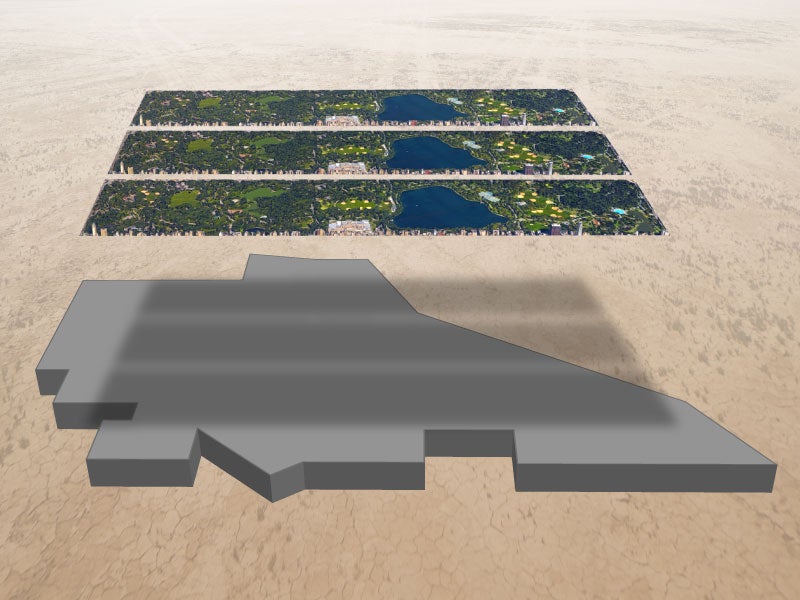A Bad Holiday Deal on New California Mega Warehouse
As online shopping heats up for the holiday season, we’re lifting the veil on the freight industry and communities’ campaigns to make major freight hubs like mega warehouses greener and cleaner.

This page was published 9 years ago. Find the latest on Earthjustice’s work.
The story of the World Logistics Center, a proposal to build what might be the largest warehouse in the world, has many twists and turns. Recently, another twist shocked those following this astoundingly massive freight project, led by a powerful developer seeking to skirt vital environmental regulations that protect the local community.
On November 1st, the court approved a disastrous settlement between the lead agency in Southern California that regulates air pollution and the project developer. If built, the World Logistic Center will be located in Moreno Valley and cover the equivalent of roughly three Central Parks or 30 Disneylands. It’s estimated that the center will see more than 14,000 truck trips every day, creating a toxic hotspot for cancer-causing diesel fumes.
The impacts on local families breathing the air in the Inland Empire day in and day out could be dire. According to the American Lung Association, the Inland Empire, which includes Moreno Valley, has some of the worst air quality in the nation. Children in the area suffer from over 104,000 cases of pediatric asthma, and an estimated 808 people die annually from the heart and lung problems caused by air pollution. (Problems like this aren’t confined to Southern California, either; the EPA estimates that over 50 million Americans live near major freight paths and are subjected to dirty emissions in the air that can harm their health.)
The failure to fully address the potential health and environmental impacts of the World Logistics Center led to numerous government, labor and community voices, including those represented by Earthjustice, bringing enforcement actions to ensure the city of Moreno Valley complies with the law. One of those government agencies was the South Coast Air Quality Management District, the agency tasked with regulating and enforcing clean air laws to protect public health. The air district alleged that the city, in approving a project of such “unprecedented scale,” violated the law in part by failing to properly address or mitigate the significant air quality and greenhouse gas emissions that would be caused by the new diesel truck traffic. They also noted that the city failed to consider or adopt a host of specific mitigation measures that would reduce some of these dangerous emissions, including requiring new truck technologies and emissions caps, ensuring trucks are certified with the most current emissions standards and replacing or retrofitting dirtier, older trucks.
However, the settlement reached between the air district and the city and developer does one thing and one thing only: It imposes a fee of $0.64 per square foot for each building constructed as part of the warehouse. The air district is allowed to spend this money “for any purpose that will improve the air quality in the South Coast Air Basin.” The settlement further states that the monies received from this fee will “adequately mitigate heavy-duty truck related air quality impacts” resulting from the World Logistics Center.
In other words, the developer and the air district claim without one scintilla of evidence that the millions of dollars generated by this fee will offset the harms created by this enormous project. We disagree.
Upon initial review, one might think this is a good settlement. Up to $25 million that could go toward improving air quality—that’s a lot of money. But a closer inspection reveals that it’s actually a raw deal for the millions of people living in this toxic air basin.
As a former prosecutor who negotiated enforcement actions against violating entities for more than 15 years, I know firsthand the power the government has to negotiate strong settlements that ensure, among other things, that the violator repairs the harm caused by the unlawful action. What is strikingly missing from this settlement is any promise that the money will go directly toward mitigating the impacts from the 14,000 daily diesel truck trips to the logistics center.
All the settlement does is guarantee that millions will go to the air district to spend as it sees fit. Could it be used on projects that do not even address diesel pollution in other parts of the region? Could it go toward salary increases, given that air district jobs arguably improve air quality? We don’t know because they won’t say. There is no guarantee of place or time of use. No requirement for community input, let alone from the community most impacted. That means there’s nothing in this settlement that’s enforceable.
The air district had a great opportunity to force the developer to implement some real changes in the project that would benefit the communities nearby. Instead, the communities the air district is tasked with protecting get no guarantees. As a result, if our current efforts to fight this unwise development in court fall flat, millions of families in the Inland Empire could pay the price with dire health impacts from dirty diesel fumes in the air they breathe.
Read the latest news coverage on our case with community partners against the World Logistics Center.
The California Regional Office fights for the rights of all to a healthy environment regardless of where in the state they live; we fight to protect the magnificent natural spaces and wildlife found in California; and we fight to transition California to a zero-emissions future where cars, trucks, buildings, and power plants run on clean energy, not fossil fuels.